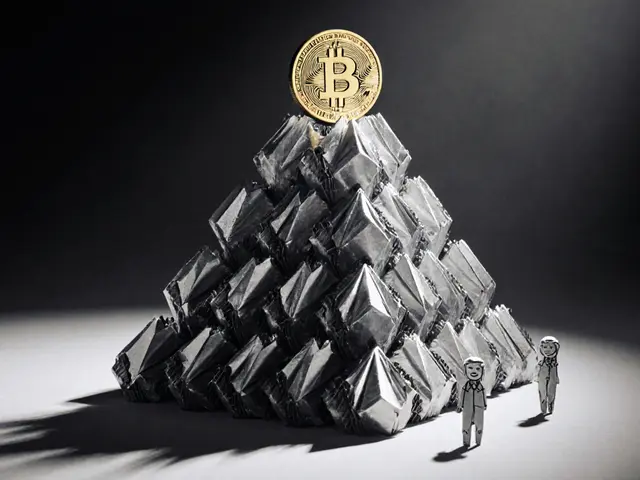Mining Profitability Calculator
Profitability Results
Daily Revenue
Gross Revenue: $0.00
Electricity Cost: $0.00
$0.00
Bitcoin used to be the only game in town for crypto miners. Back in 2010, you could mine it on a regular laptop. Today, that’s impossible. The network’s hash rate has skyrocketed, and mining Bitcoin now demands serious money, serious power, and serious hardware. Meanwhile, altcoins like Monero, Litecoin, and Ethereum Classic still let you plug in your old GPU and start mining without selling a kidney. So in 2025, is Bitcoin mining still worth it-or should you jump to altcoins?
Bitcoin Mining: The High-Stakes Game
Bitcoin mining in 2025 isn’t a hobby. It’s an industrial operation. After the April 2024 halving, block rewards dropped to 3.125 BTC per block. That’s half of what miners earned just four years earlier. To stay profitable, you need top-tier ASIC miners like the Whatsminer M50 or Bitmain Antminer S21. These machines cost between $3,000 and $10,000 each, consume 3,000+ watts, and need serious cooling.
And even then, you’re not guaranteed profit. The network difficulty adjusts every two weeks based on how much total computing power is online. As of November 2025, Bitcoin’s hash rate sits above 800 exahashes per second. That means if you’re mining solo with one ASIC, your chances of finding a block are practically zero. You have to join a mining pool-and pay a fee for it. Most profitable Bitcoin miners now operate in places like Texas, Kazakhstan, or Georgia, where electricity costs under $0.05 per kWh.
On average, a single high-end ASIC generates about $10-$15 per day in Bitcoin revenue, but after electricity and maintenance, net profit often drops to $2-$5 daily. That’s why only large mining farms with hundreds or thousands of machines can make consistent money. For individuals? Unless you have access to near-free power, Bitcoin mining in 2025 is a money-losing bet.
Altcoin Mining: The Accessible Alternative
Not all cryptocurrencies are built like Bitcoin. Altcoins like Monero, Litecoin, and Ethereum Classic were designed with different goals-and different mining rules.
Monero is the poster child for decentralized mining. It uses the RandomX algorithm, which is intentionally optimized for CPUs and GPUs. That means you can mine it with your gaming rig or even an old office laptop. No ASICs allowed. That’s by design. Monero’s developers want to prevent centralization. In 2025, miners using a mid-range NVIDIA RTX 4070 can earn around 0.15-0.25 XMR per month, worth roughly $20-$35 depending on price. With electricity costs around $0.12/kWh, that’s still a net profit of $10-$25 monthly-without spending a dime on new hardware.
Litecoin is often called “Bitcoin’s lighter cousin.” It has faster block times (2.5 minutes vs. 10), lower difficulty, and a fixed reward of 6.25 LTC per block. You can mine it with ASICs too, but they’re cheaper than Bitcoin ASICs. The Goldshell LT6, for example, costs under $1,000 and generates $5-$8 daily in Litecoin revenue. After power costs, net profit is often $2-$4 per day. That’s less than Bitcoin ASICs, but you get there with a fraction of the upfront cost.
Ethereum Classic still uses Proof of Work, unlike Ethereum, which switched to Proof of Stake in 2022. That means GPU miners can still earn ETC. With an RTX 3060, you can mine around 0.3-0.5 ETC per day. At current prices, that’s $3-$5 daily. Again, no ASIC needed. Just plug in your existing rig.
Hardware Showdown: ASIC vs GPU
The biggest difference between Bitcoin and altcoin mining? The hardware.
Bitcoin mining requires ASICs-specialized chips built for one thing: solving SHA-256 hashes. These machines are expensive, loud, hot, and useless for anything else. If Bitcoin’s price drops, your ASIC becomes a paperweight.
Altcoins like Monero and Ethereum Classic use memory-hard algorithms. They’re designed to be mined on standard GPUs and CPUs. That means your mining rig can double as a gaming PC, a video editor, or a home server. If the coin’s price crashes, you can still use the hardware for other things. That flexibility matters.
Here’s a quick comparison:
| Criteria | Bitcoin | Litecoin | Monero | Ethereum Classic |
|---|---|---|---|---|
| Minable With | ASIC only | ASIC recommended | GPU/CPU | GPU |
| Hardware Cost | $3,000-$10,000+ | $800-$1,500 | $0 (use existing PC) | $0 (use existing PC) |
| Power Use (Watts) | 3,000-3,500 | 1,800-2,200 | 150-300 (per GPU) | 130-180 (per GPU) |
| Block Time | 10 minutes | 2.5 minutes | 2 minutes | 13 seconds |
| Profit Potential (Daily Net) | $2-$5 (per ASIC) | $2-$4 (per ASIC) | $1-$2 (per RTX 4070) | $1-$3 (per RTX 3060) |
Notice something? You can run four RTX 4070 GPUs for less than the cost of one Bitcoin ASIC. And if one coin’s price drops, you can switch to another-Monero, Ravencoin, or Zcash-without buying new hardware.

Profitability: Stability vs Flexibility
Bitcoin mining is like investing in a blue-chip stock. It’s slow, predictable, and dominated by big players. The price doesn’t swing wildly every day. The halving schedule is set in stone. That’s good for long-term planning-but bad for small operators.
Altcoin mining is more like day trading. Prices can spike 50% in a week, or crash 30% overnight. But the entry barrier is low, and you can pivot fast. If Monero’s price jumps because of new privacy regulations, your GPU mining rig suddenly becomes more profitable. If Litecoin gets adopted by a major payment processor, you’re already mining it.
According to Coin Bureau’s 2025 analysis, altcoin miners who switch between coins based on profitability (using tools like WhatToMine or NiceHash) can outperform Bitcoin miners who stick to one rig. Why? Because they’re not locked in. They’re agile.
Also, altcoins like Monero and Litecoin have no plans to switch to Proof of Stake. That means their mining models are safe for the foreseeable future. Ethereum Classic’s community is fiercely committed to PoW. These aren’t fading projects-they’re holding the line.
Who Should Mine What?
Let’s cut through the noise. Who actually benefits from mining Bitcoin in 2025?
- You should mine Bitcoin if you’re part of a large mining operation with access to industrial power, cooling infrastructure, and capital to buy 100+ ASICs. You’re not a hobbyist-you’re a business.
- You should mine altcoins if you’re an individual with a spare GPU, a home setup, or limited budget. You want flexibility, lower risk, and the ability to walk away if things turn sour.
Most people who start mining Bitcoin in 2025 lose money. They buy an ASIC, pay for expensive electricity, join a pool, and after six months, realize they’re barely breaking even. Meanwhile, someone mining Monero on their old laptop is making $20 a month-risk-free, with zero upfront cost.

Real-World Example: Two Miners, Two Paths
Meet Alex and Jamie.
Alex spent $15,000 on three Bitmain Antminer S21s. He lives in Florida, where electricity is $0.14/kWh. After three months, he’s netted $1,200 in profit. His machines are loud, hot, and constantly needing maintenance. He’s now thinking about selling them.
Jamie bought a used RTX 3060 for $200. Installed XMRig. Started mining Monero. Electricity cost? $0.11/kWh. After three months, Jamie made $1,800 in Monero. The GPU still runs their home PC. When Monero dipped, they switched to Ravencoin for two weeks. When it bounced back, they switched again. No debt. No stress. Just steady, flexible earnings.
Who won? Jamie did. Not because Monero is “better”-but because their approach matched their resources.
The Future of Mining in 2025 and Beyond
Bitcoin mining will keep getting harder. More ASICs. More consolidation. More regulation. The days of “mine Bitcoin and get rich” are over.
Altcoin mining? It’s evolving. New coins are launching with ASIC-resistant algorithms. Mining software is getting smarter. Profitability trackers are more accurate. You can now auto-switch between coins with one click.
The real winners in 2025 won’t be the ones with the biggest ASIC farms. They’ll be the ones who understand flexibility, cost control, and adaptability. Mining isn’t about chasing the biggest coin anymore. It’s about matching your tools to your situation.
If you’re starting today, skip the Bitcoin ASIC. Start with a GPU. Mine Monero or Ethereum Classic. Learn the ropes. See how the market moves. When you’re ready to scale, you’ll know exactly what to do.
Is Bitcoin mining still profitable in 2025?
Bitcoin mining is only profitable for large-scale operations with access to cheap electricity (under $0.05/kWh) and hundreds of ASICs. For individuals, it’s rarely profitable unless you already own the hardware and have near-free power. Most small miners lose money after accounting for electricity, cooling, and maintenance.
Can I mine altcoins with my regular computer?
Yes. Monero, Ethereum Classic, and Ravencoin can all be mined with standard CPUs and GPUs. You don’t need special hardware. Just install free mining software like XMRig or GMiner, join a pool, and start. Many people mine these coins on old gaming rigs or home PCs with no upfront cost.
Which altcoin is the most profitable to mine in 2025?
There’s no single answer-profitability changes daily. As of late 2025, Monero and Ethereum Classic offer the best balance of low hardware requirements and steady rewards. Litecoin is profitable if you have an ASIC, but not with a GPU. Use tools like WhatToMine or MinerStat to check real-time profitability before you start.
Do I need to join a mining pool?
For Bitcoin, yes-you need a pool. For altcoins like Monero or Ethereum Classic, you can mine solo, but it’s not practical. Pools combine your hash power with others, giving you smaller but more frequent payouts. Most miners use pools because they’re more reliable and pay out daily.
Is mining altcoins safe from regulatory risk?
All mining faces regulatory uncertainty. But altcoins like Monero and Zcash are designed for privacy, which makes them targets for regulation. Bitcoin is more visible, but also more established. The safest approach is to mine in jurisdictions where crypto mining is legal and avoid hiding your operations. Transparency reduces risk.
Should I buy an ASIC for altcoin mining?
Only if you’re mining Litecoin or Dogecoin, since they use Scrypt and have ASIC-compatible algorithms. For Monero, Ethereum Classic, or Zcash, ASICs don’t work. Buying an ASIC for these coins is a waste of money. Stick to GPU mining for maximum flexibility and resale value.
If you’re thinking about getting into mining in 2025, forget the hype. Don’t chase Bitcoin. Start small. Use what you already have. Learn how the market moves. The real opportunity isn’t in the biggest coin-it’s in the smartest strategy.





James Edwin
Just started mining Monero on my old RTX 3070 last month. Made $42 in three weeks. No ASIC, no debt, just a quiet rig in the corner. This post nailed it - stop chasing Bitcoin like it’s 2017.
Tim Lynch
The real tragedy isn’t that individuals can’t mine Bitcoin anymore - it’s that we’ve turned a decentralized experiment into a Wall Street derivative wrapped in silicon. The ethos of crypto was autonomy. Now we worship hash rate like it’s a god. The altcoin miners? They’re the last true believers.
andrew casey
One must acknowledge the fundamental asymmetry inherent in the Bitcoin mining ecosystem: capital efficiency dictates participation. The notion that a GPU miner can meaningfully compete is a romantic fallacy rooted in nostalgia. The market rewards scale, not sentiment. One does not challenge oligopolies with consumer-grade hardware.